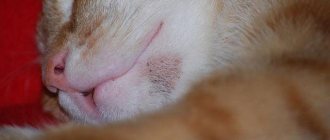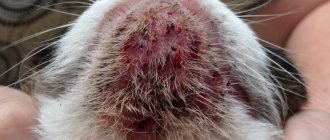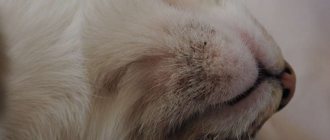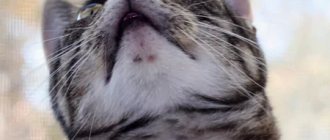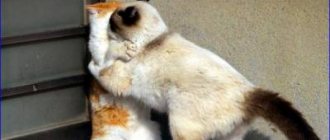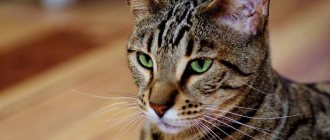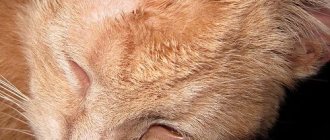Acne in cats is a skin condition that appears as rashes. The most interesting thing is that this disease also occurs in humans. Unlike humans, acne in cats is not caused by puberty. In life, this disease has other names, such as “blackheads” and “acne.”
In simple terms, acne is an inflammation of the sebaceous glands. For the most part, the Don Sphynx and the Persian breed suffer from this disease.
Due to the lack of fur, Don Sphynxes have skin that is more exposed to the external environment. Therefore, the likelihood of irritation throughout the body increases. And in the Persian breed, due to the folds on the muzzle, food accumulates near the oral cavity. If these residues are not removed in time, the pet may become inflamed.
Causes of acne in cats
Acne usually appears when the sebaceous glands malfunction. The process is based on the exfoliation of dead cells and secretions secreted by gland cells. For this reason, the ducts become clogged, due to peeling and secretion, the skin microflora deteriorates and stops multiplying, and as a result, irritation occurs. Experts have not yet fully figured out why this happens.
There can be quite a lot of factors for the appearance of “black dots”. The reasons are exogenous (external) and endogenous (internal). If this happens, you should think about and reconsider caring for your pet.
Endogenous factors of acne are considered:
- hormonal disbalance;
- metabolic disease;
- allergies to objects, food;
- liver problems;
- individual skin characteristics;
- the appearance of parasites in the body.
Exogenous factors are considered:
- dirty food bowls - the animal gets its face dirty, and food debris blocks the sebaceous ducts;
- When sick or old, cats begin to wash themselves poorly or stop taking care of themselves altogether;
- wounds and scratches can cause irritability;
- overvoltage;
- poor nutrition.
The main factors include:
- Incorrect feeding. The pet must receive all the necessary food for the normal functioning of the body. Malnutrition and overfeeding should be avoided.
- Infection. If an animal has bacterial or fungal infections, this can have a bad effect on the body, including the skin.
- Paraanal glands. This is also considered an important factor, since they directly affect the normal functioning of the skin. And even if your pet’s anal glands are fine, it’s still better to play it safe and have them checked.
- Bowl for food. First of all, you need to pay attention to what kind of dishes your cat eats from, what material the bowls are made of, and what sanitary condition they are in.
Important! Spayed and neutered cats are least susceptible to this disease. This is due to changes in the pet’s hormonal levels after surgery, which is not prone to rapid changes in sexual activity.
Diagnostic measures
If a cat develops pimples, it is important for the owner not to self-treat the pet and take it to a veterinarian. The doctor will conduct a visual examination of the cat’s skin, after which he will prescribe the required examinations. During the diagnostic process, it is important to exclude the presence of diseases in the animal that can cause acne:
The animal's condition must be differentiated from demodicosis.
- demodicosis;
- leprosy;
- dermatophytosis;
- fungus;
- tumor of the sebaceous glands.
Symptoms
Often, the cat's owner does not even realize that his pet has acne until he notices black dots in the chin area or on another part of the body. The animal may feel fine for a long time until severe itching appears. Males are known to suffer more often due to the effects of testosterone on the base of the tail.
There are signs by which it is easy to determine the initial stage of acne:
- at the site of future inflammation, the coat becomes shiny;
- a yellowish color is noticeable;
- Black dots appear on the skin, which are most often confused with ordinary dirt or flea eggs.
The main locations of acne on the body in cats:
- chin;
- lip;
- muzzle;
- back;
- base of tail;
- near the eyebrows;
- near the ears;
- in the corners of the mouth;
- on the stomach.
Four stages of the disease :
- skin redness;
- acne formation;
- the pimple matures, pus forms at the top, which breaks out after a while;
- if the process goes smoothly, the wound heals and the skin gradually recovers.
Important! The process can worsen when, with a weakened immune system, pus infects a healthy area, which is considered extremely dangerous to health.
With complications, acne develops into purulent skin lesions. Swelling appears and gradually increases.
How does a cat's behavior change?
- the animal behaves restlessly;
- frequently licks the affected area;
- feels severe discomfort, unbearable itching and itches all the time.
If a Sphynx cat's eyes are watery
Brownish and transparent light discharge from a cat's eyes is normal. If white or yellow liquid with a purulent odor flows intensively from the eyes, then an infection should be suspected. The medicine is prescribed by a veterinarian.
Sphynx kittens are born with open eyelids, so from birth there is a high probability of:
- injuries;
- inflammatory processes;
- allergies;
- conjunctivitis;
- corneal ulceration.
Adult Sphynx cats have watery eyes due to allergies or conjunctivitis, which is caused by the lack of eyelashes protecting the eyeballs.
For preventive purposes, the eyes of sphinxes are wiped with tea leaves, chamomile infusion, boiled water or a veterinary remedy.
Acne treatment
Treatment of this disease in cats at home is that the first step is to cleanse the skin of excess secretions and stop the appearance of acne.
The algorithm of actions is as follows:
- The hair in the damaged area must be shaved.
- The affected area is treated several times a day with a special solution (peroxide, chlorhexidine).
- To remove the top layer of epithelium, this can be done using salicylic acid.
If a cat has an infectious disease, then treatment without antibiotics is inevitable. In order to know which drugs will be needed, you need to be tested in a specialized laboratory, the study will show a drug sensitivity test and determine the bacterial culture.
Important! Tests must be taken to determine the presence of infection in the affected area, since antibiotics cannot be taken for a fungal infection.
What rules should you follow:
- pimples should not be squeezed out (the pus should come out on its own);
- the damaged area must be treated carefully, pointwise, so that the skin does not dry out;
- make sure that the animal does not scratch itself;
- You can’t always use drugs containing alcohol, this provokes inflamed acne;
- Apply a thin layer of special creams so that air can penetrate (this is necessary for healing).
Important! If pimples appear very often, the cause may be in the pet’s body. In all likelihood, it will be related to the intestines or liver.
To prevent recurrence of the disease, it is better to replace plastic dishes for your pet with higher quality ones made of stainless steel or ceramics, also change the litter for the tray and bathe the cat using professional shampoos.
Antiseborrheic shampoos and tar soap
Products such as antiseborrheic shampoo and tar soap do an excellent job of treating the skin. The cleaned area is washed with special soap or shampoo. The product is left on the skin for five minutes and then, with great care, wipe the skin with a cotton swab until dry.
Preparations for acupressure
The disease goes away faster if salicylic alcohol or ointment is applied to the skin, this helps soften the skin. To neutralize the area you will need hydrogen peroxide. Iodine is used to cauterize the surface of the epithelium. Calendula tincture also helps a lot. A gauze bandage soaked in tincture is applied to the affected area, and in the near future a good result will not be long in coming.
To make pimples go away faster, use solutions of chlorophyllipt and clotrimazole 1%. In treatment, effective drugs such as Percutan, Chlorhexidine or Miramistin are used to safely treat the irritated area of skin before visiting a doctor.
It is important to ensure that the cat does not lick the medications.
Course of treatment with corticosteroids
Acne can lead to very severe inflammation and in this case the doctor will prescribe a course of treatment with corticosteroids, usually prednisolone.
Folk remedies
An equally common way to treat acne are decoctions:
- Choose any glass container, add 20 g of chamomile and calendula. Pour hot water and bring to a boil over low heat. The resulting broth is filtered. Grind two tablets of the drug, add approximately 15 ml of decoction. It is enough to make a mask every other day, leave for 20 minutes. Use a towel to clean it all up.
- Cut the pumpkin into small pieces. These pieces are used to wipe acne. The skin should be treated with an antiseptic and pieces of pumpkin should be placed on the affected area for 5 minutes.
- Add 20 g of yarrow to a glass of water (preferably dried). Pour boiling water over the flowers, cover with a lid and let steep for an hour. This is an excellent substitute for lotion; use a cotton swab to wipe the irritated area in the morning and evening.
- Celandine copes well with inflammation. Add a spoonful of celandine to a glass of water and bring to a boil in a water bath. Boil for 5-7 minutes, then let the resulting liquid cool. Treat acne twice a day, warming the broth to 40 degrees.
What to do at home
According to the treatment and nutrition regimen prescribed by the doctor, it is necessary to begin restoring the pet’s health.
Noting the sensitivity of sphinxes to various drugs, as well as food compounds of proteins and carbohydrates, you need to carefully monitor your pet’s skin. If spots (rashes, ulcers, etc.) increase, you should immediately contact the clinic to adjust the course.
When taking medications, you should pay attention to the dosage depending on the weight and age of the animal. Overdose is unacceptable.
Diagnostic nutrition should be given only in the combination indicated by the doctor. Deviations from the diagnostic diet are unacceptable.
To eliminate the sphinx’s nervousness due to the lack of treats and the need to take medications, you should pay more attention to the animal, as well as regularly change drinking water and provide it with a warm sleeping place.
Disease prevention
Every effort can be made to reduce the likelihood of acne in cats. To do this you need to adhere to certain rules. Do not try to give your pet very greasy or fatty foods. Human food can harm your pet and contribute to various diseases.
You should always wash dishes from which your cat drinks or eats. Replace plastic bowls with metal or glass ones. This will prevent bacteria from multiplying. Monitors the cat's fur and well-being, and keeps the house clean. It is advisable to visit a veterinarian once every six months to make sure your cat is healthy.

